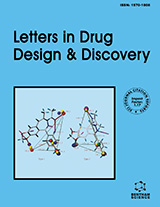Abstract
A 3D-QSAR selectivity analysis of 53 adamantyl heteroaryl urea derivatives active against M. tuberculosis is reported. These analogs inhibit Mycobacterial Membrane Protein Large 3 (MmpL3), a proposed transporter for cell wall mycolic acids. However, these analogs also exhibit affinity towards human soluble epoxide hydrolase (sEH) enzyme, making them pharmacologically undesirable. Thus, COMFA and CoMSIA selective studies viz ligand and receptor-based alignment has been described to evaluate key pharmacophoric structural features that may possibly play a crucial role for selective inhibition. This hypothesis was experimentally validated and successfully tested on four novel adamantyl urea based derivatives with known biological activity. Therefore, this approach may pave way to novel specific inhibitors in tuberculosis drug discovery process.
Keywords: CoMFA, CoMSIA, docking, homology modelling, human sEH, MmpL3, tuberculosis.
Current Computer-Aided Drug Design
Title:3D-QSAR Selectivity Analysis of 1-Adamantyl-3-Heteroaryl Urea Analogs as Potent Inhibitors of Mycobacterium tuberculosis
Volume: 11 Issue: 2
Author(s): Preeti Wadhwa, Sourav Bagchi and Anuj Sharma
Affiliation:
Keywords: CoMFA, CoMSIA, docking, homology modelling, human sEH, MmpL3, tuberculosis.
Abstract: A 3D-QSAR selectivity analysis of 53 adamantyl heteroaryl urea derivatives active against M. tuberculosis is reported. These analogs inhibit Mycobacterial Membrane Protein Large 3 (MmpL3), a proposed transporter for cell wall mycolic acids. However, these analogs also exhibit affinity towards human soluble epoxide hydrolase (sEH) enzyme, making them pharmacologically undesirable. Thus, COMFA and CoMSIA selective studies viz ligand and receptor-based alignment has been described to evaluate key pharmacophoric structural features that may possibly play a crucial role for selective inhibition. This hypothesis was experimentally validated and successfully tested on four novel adamantyl urea based derivatives with known biological activity. Therefore, this approach may pave way to novel specific inhibitors in tuberculosis drug discovery process.
Export Options
About this article
Cite this article as:
Wadhwa Preeti, Bagchi Sourav and Sharma Anuj, 3D-QSAR Selectivity Analysis of 1-Adamantyl-3-Heteroaryl Urea Analogs as Potent Inhibitors of Mycobacterium tuberculosis, Current Computer-Aided Drug Design 2015; 11 (2) . https://dx.doi.org/10.2174/1573409911666150803154114
| DOI https://dx.doi.org/10.2174/1573409911666150803154114 |
Print ISSN 1573-4099 |
| Publisher Name Bentham Science Publisher |
Online ISSN 1875-6697 |
 49
49 1
1
- Author Guidelines
- Bentham Author Support Services (BASS)
- Graphical Abstracts
- Fabricating and Stating False Information
- Research Misconduct
- Post Publication Discussions and Corrections
- Publishing Ethics and Rectitude
- Increase Visibility of Your Article
- Archiving Policies
- Peer Review Workflow
- Order Your Article Before Print
- Promote Your Article
- Manuscript Transfer Facility
- Editorial Policies
- Allegations from Whistleblowers
Related Articles
-
Review of Structures Containing Fullerene-C60 for Delivery of Antibacterial Agents. Multitasking model for Computational Assessment of Safety Profiles
Current Bioinformatics Rheumatoid Nodules and Lung
Current Respiratory Medicine Reviews Editorial [ Infectious Diseases: What is in our future? ]
Infectious Disorders - Drug Targets Advances of Bioinformatics Applied to Development and Evaluation of Boron-Containing Compounds
Current Organic Chemistry Is There an Increased Risk of Lymphoma and Malignancies Under Anti- TNF Therapy in IBD?
Current Drug Targets Design, Synthesis and Antiproliferative Activities Evaluation of Thiazolopyrimidines Derivatives through Biginelli Reaction
Letters in Drug Design & Discovery Epidemiology and Management of Infectious Complications in Contemporary Management of Chronic Leukemias
Infectious Disorders - Drug Targets Antimycobacterial Assessment and Microwave-assisted Synthesis of 2-aryl- 3-(4-methylphenylamino)thiazolidin-4-one Derivatives
Letters in Organic Chemistry Other Activities
Current Bioactive Compounds Different Methods for Molecular and Rapid Detection of Human Novel Coronavirus
Current Pharmaceutical Design Evaluation of Inflammatory Biomarkers in Iranian Patients with Cystic Fibrosis
Current Respiratory Medicine Reviews RNA Interference-Based Therapeutics: New Strategies to Fight Infectious Disease
Infectious Disorders - Drug Targets Nitrofurans as Novel Anti-tuberculosis Agents: Identification, Development and Evaluation
Current Topics in Medicinal Chemistry Bicyclic 6 + 6 Systems: Advances in the Chemistry of Heterocyclic Compounds Incorporated Pyrimido[1,2-a]Pyrimidine Skeleton
Mini-Reviews in Organic Chemistry Bio-Inspired Algorithms Applied to Molecular Docking Simulations
Current Medicinal Chemistry Role of Estradiol in the Expression of Genes Involved in Serotonin Neurotransmission: Implications for Female Depression
Current Neuropharmacology Potential Use of Protease Inhibitors as Vaginal and Colorectal Microbicides
Current HIV Research Low-Cost Infertility Management
Current Women`s Health Reviews Despite an Extensive Sequence Analysis Identification of Functional Candidates Amongst Hypothetical Proteins of Neisseria gonorrhoeae
Letters in Drug Design & Discovery The Antibacterial Activity of Metal Complexes Containing 1,10- phenanthroline: Potential as Alternative Therapeutics in the Era of Antibiotic Resistance
Current Topics in Medicinal Chemistry


























